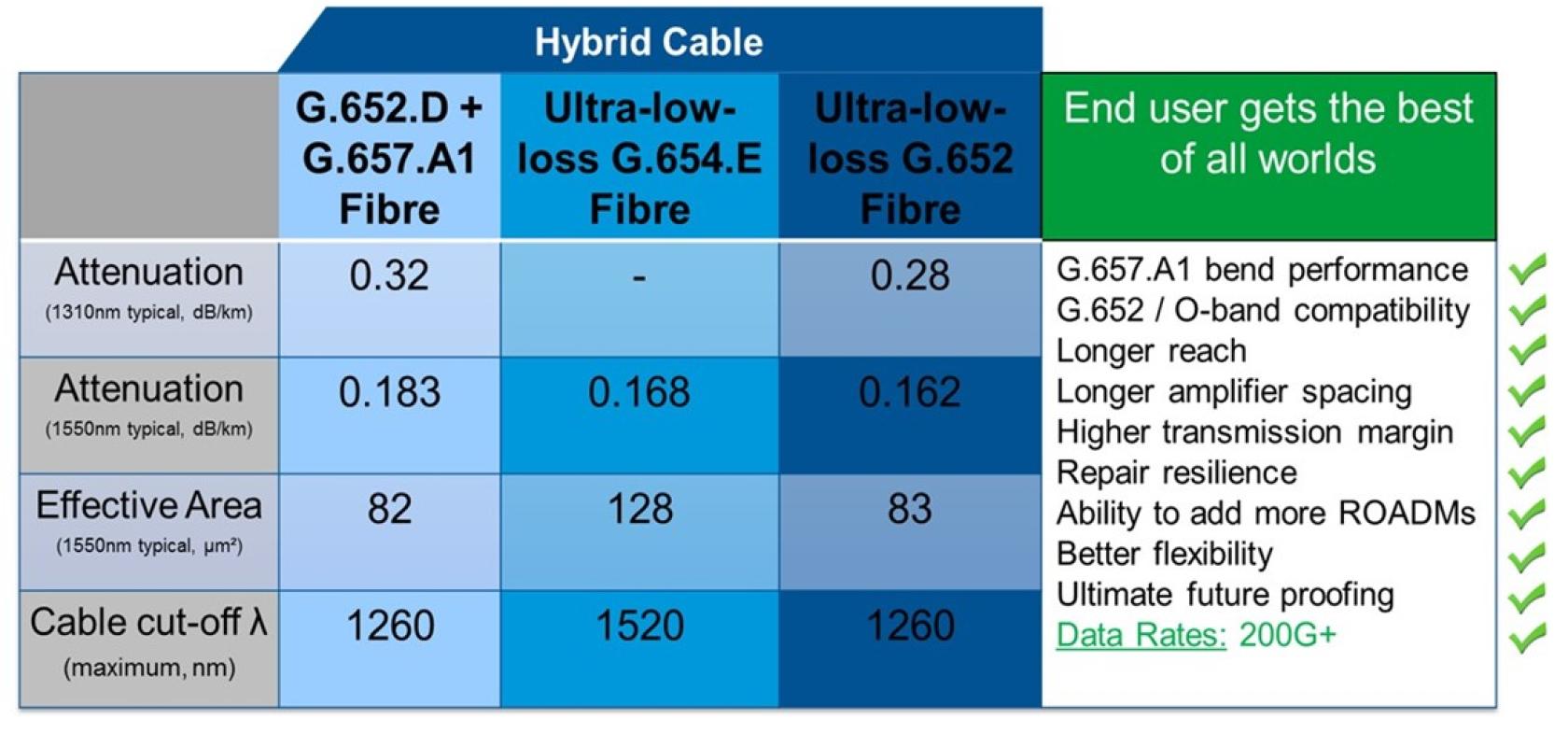A look at building future-ready terrestrial networks with hybrid optical fibre cables, with Sergei Makovejs and Matthew Guinan
As demand for bandwidth continues to grow and the applications driving it evolve, network operators face the difficult task of preparing their physical optical infrastructure for a future that cannot always be envisaged.
The precedents in which new technologies fundamentally change the way the optical networks are built have happened before, with the most recent and vivid example being the transition to coherent systems in late 2000s – this shifted the focus away from managing chromatic dispersion to managing noise and nonlinearity.
Given that the memories of such a disruptive technological change are still fresh and that at least another disruption over the lifetime of the cable is almost inevitable, operators are naturally on the lookout for future-proof solutions. The is to make the right decision on passive infrastructure deployment in the presence of incomplete information on future transmission technologies and future network architectures. One way to address this challenge is to deploy hybrid cables to account for potential disruptions that next-generation transmission technologies may bring.
What is a hybrid cable?
Simply put, a hybrid optical fibre cable is one that features two or more different fibre types within the same physical construction to provide greater flexibility for the network operator. Each of the fibre types can also serve its own purpose. For example, ITU-T recommends G.652.D compliant fibre (which can be simultaneously compatible with G.657.A1) to support direct connections to business customers in a metropolitan network.
Conversely, ultra-low-loss G.652 fibre or G.654.E fibre can be used to carry aggregated traffic over longer routes. The benefits of such ultra-low-loss fibres is their ability to provide higher transmission capacity, longer amplifier spacing, better transmission margin, stronger repair resilience, or a combination of all of the above. Another, and perhaps frequently overlooked benefit, is the ability to accommodate more reconfigurable optical add-drop multiplexers (ROADMs) in transparent network architectures.
It is likely that such networks will become mainstream in the next 10 years, therefore the decision made today on the fibre plant could reverberate for the next decade and beyond. Deploying optical cables containing hybrid fibre types can give peace of mind that passive infrastructure will be able to cope with what the future throws at it.
Ask yourself this
A natural question to ask is what should be the split between a traditional G.652.D fibre and ultra-low-loss G.652 / G.654.E fibre? It really depends on the amount of data traffic that is provisioned for the long-haul part of the network versus the amount of data traffic that is expected to stay within a metropolitan area. Additional requirements for route protection and redundancy may also play a role. In other words, the desired split ratio will vary from region to region, and from network to network. But a good rule of thumb could be to provision 25-50 per cent of ultra-low-loss fibre (either G.652 or G.654.E) and 50-75 per cent of regular G.652.D fibre. In principle, we do not have to limit ourselves to having just two fibre types in a cable and could stretch to three (Table 1, top image). For example, a good combination could be 25 per cent of ultra-low-loss G.652 fibre, 25 per cent of ultra-low-loss G.654.E fibre, and 50 per cent of regular G.652.D fibre.
The reasons for potentially opting for this configuration are nuanced, yet important. Ultra-low-loss G.654.E fibre typically provides better performance than ultra-low-loss G.652 fibre, but G.652 maintains O-band (1310 nm) compliance. So, the split between the three fibre types in a hybrid cable could partially be determined by O-band compliance vs. C-band transmission performance considerations.
Cable designs
The cable itself can be based on loose-tube or ribbon design, both of which can effortlessly support multiple fibre types. Identifying and splicing the correct fibres is critical in any optical cable deployment but it is arguably of even greater importance when dealing with multiple fibre types. Loose tube and ribbon cables both have design features that enable simple fibre identification, so the choice between the two then depends on handling preferences and the speed with which the cable must be installed.
Loose tube cables
Figure 1 shows a loose tube cable which is the most widely-deployed outdoor cable design. Available with up to 864 fibres, this cable type typically features groups of 12 or 24 coloured optical fibres loosely contained within coloured buffer tubes which are stranded around a central strength member, all contained within a black polyethylene (PE) jacket. Not only does this construction allow stringent fibre management, it also enables the use of different fibre types in different buffer tubes. Each of the fibre tubes can be identified quickly and easily by their simple color-coding, meaning there should be no concerns about a technician confusing fibre types during routine installation and maintenance.

Ribbon cables
Figure 2 shows a central tube ribbon cable. This cable design is also based upon groups of 12 coloured optical fibres but these are encapsulated in an array (also known as a ribbon) which are then stacked to achieve fibre counts up to 864 fibres. The ribbon stack is contained within a single, central buffer tube and the cable is finished with strength members and a black PE jacket. The ribbon itself is printed with unique identification information meaning again, an installer will be able to easily differentiate between different fibre types. The key benefit of ribbon cables that they enable mass-fusion splicing, whereby two 12-fibre ribbons can be fused in a single procedure which makes splicing a full cable up to 80 per cent faster than splicing fibres individually in a loose tube cable with an equivalent fibre count (see Table 2).

Making decisions on the types of fibre in the face of technological uncertainty that has historically surrounded the field of optical fibre communications can be difficult. Traditionally, network operators had to make tough decisions on whether to deploy Fibre X or Fibre Y, but fortunately in today’s environment a hybrid cable consisting of two or three fibre types can represent an effective solution. A hybrid cable is a mature technology and has been deployed in many long-haul networks around the world over the last several years, and we expect it will become a de-facto choice in the foreseeable future.

Matthew Guinan is market and technology development manager and Sergei Makovejs is high-data-rate optical fibre market and technology development manager at Corning Optical Communications


